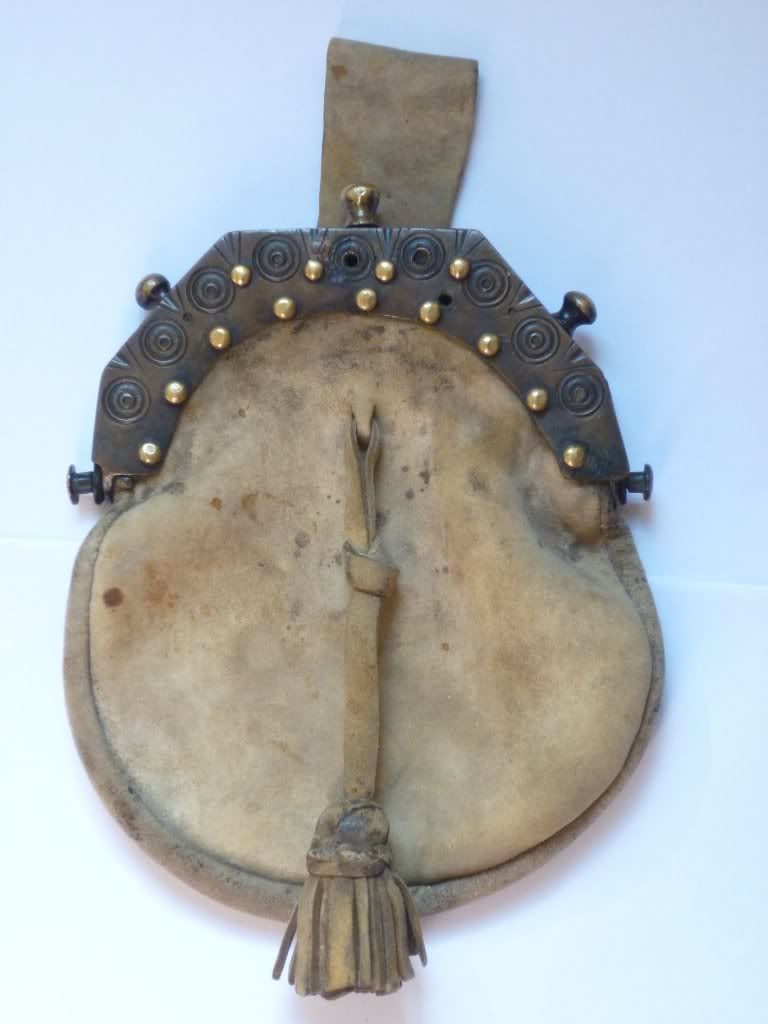|
-
Earliest use of brass-cantle sporrans?
What is the earliest reference we have of Highlanders wearing sporrans with brass cantles?
I know that the MOD cantles which have been so popular lately only hail from around the 1950s. Are they based on a specific earlier style? The reason I ask is because I only recently noticed that one of my fellow Colquhouns was wearing one very similar to the MOD brass cantles in sitting for his MacLeay portrait.

Granted, his sporran is a hair sporran, and with all those tassels, it looks very military-like. So I know that brass cantles were being worn in the mid 19th century. But how much earlier than that were they used (in any configuration, not necessarily the MOD style)? I seem to recall references to a few Jacobite-era sporrans that may have had square brass cantles. But I don't seem to have any visual representations of them.
-
-
In the notes that accompany the Delia Millar version of "The Highlanders of Scotland" there is a note that Colquhoun's sporran is something of an 'oddity' at the time, being around 100 years old.
I don't believe his is "hair" so much as it is fur.
BTW: The STM museum gallery has some nice pictures of early 1700's brass cantled sporrans HERE.
 ith: ith:
-
-
Definitely early 1700s; probably late 1600s....
Brian
"They who can give up essential liberty to obtain a little temporary safety, deserve neither liberty nor safety." ~ Benjamin Franklin
-
-
 Originally Posted by Woodsheal

Definitely early 1700s; probably late 1600s....
Agreed.
-
-
Great info, thanks!
That's the first time I had seen the early 1700s sporran on the STM site. I see that the cantle has the same concentric circle grooves that appear on the MOD sporran cantles. Is there some specific significance to these? They make for a nice decorative effect, to be sure, but seeing them used on brass cantles for such a long time seems to suggest that there's something more to it. Any clue?
Artificer, yes, I suppose it would properly be called a fur sporran rather than a hair sporran. But in the end, isn't fur and hair the same thing? 
-
-
 Originally Posted by Tobus

They make for a nice decorative effect, to be sure, but seeing them used on brass cantles for such a long time seems to suggest that there's something more to it. Any clue?
They are ancient devices most often found as petroglyphs in Scotland, Northern England and Ireland (but also elsewhere -- I've seen them in Graubunden and in the Po Valley) and called "cup and ring". Archeologists can't yet attribute anything to them other than a pleasing pattern, so whatever their connection with 17C and 18C sporran cantles it is unlikely to be anything more than decorative.
Last edited by ThistleDown; 6th July 12 at 09:09 PM.
-
-
Here is one in Glasgow Museum
http://collections.glasgowmuseums.co...09432&i=387538
And there are more than a few from this era in the National Museum in Edinburgh, Walter Scott’s house and dotted around in small-town museums and castles in Scotland.
The ring designs seem to pop up everywhere. They are on Pictish symbol stones and Saxon sword hilts as well as Scottish sporrans.
It's coming yet for a' that,
That Man to Man, the world o'er,
Shall brothers be for a' that. - RB
-
-
 Originally Posted by MacRobert's Reply

Here is one in Glasgow Museum
http://collections.glasgowmuseums.co...09432&i=387538
And there are more than a few from this era in the National Museum in Edinburgh, Walter Scott’s house and dotted around in small-town museums and castles in Scotland.
The ring designs seem to pop up everywhere. They are on Pictish symbol stones and Saxon sword hilts as well as Scottish sporrans.
Awesome sporran! I wish I would have been the person who found that beauty! Makes you wonder how many other "treasures" are still buried in and around Scotland...waiting to be found. A good mate of mine, Sandy Macpherson, who lives in Edinburgh, has an old basket-hilt sword in which he found around the hills of Glen Banchor, buried under a bit of heather and peat. He stumbled across it whilst hill-walking as a young boy in the 1940's.
Cheers,
-
-
 Originally Posted by creagdhubh

Awesome sporran! I wish I would have been the person who found that beauty! Makes you wonder how many other "treasures" are still buried in and around Scotland...waiting to be found. A good mate of mine, Sandy Macpherson, who lives in Edinburgh, has an old basket-hilt sword in which he found around the hills of Glen Banchor, buried under a bit of heather and peat. He stumbled across it whilst hill-walking as a young boy in the 1940's.
Cheers,
I've posted this before but here it is again.

This is a family sporran. What's of particular interest is the fact that the cantle is (I'm told) sand cast bronze and not brass. Doeskin bag with fully working catch. I guess it must be c1700-50.
-
-
7th July 12, 11:46 AM
#10
 Originally Posted by figheadair

I've posted this before but here it is again.

This is a family sporran. What's of particular interest is the fact that the cantle is (I'm told) sand cast bronze and not brass. Doeskin bag with fully working catch. I guess it must be c1700-50.
Good Grief Peter, I never tire of seeing that piece. Such a beauty!
 ith: ith:
-
 Posting Permissions
Posting Permissions
- You may not post new threads
- You may not post replies
- You may not post attachments
- You may not edit your posts
-
Forum Rules
|
|























Bookmarks